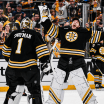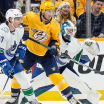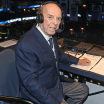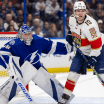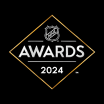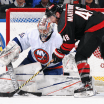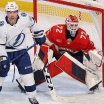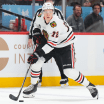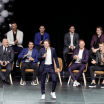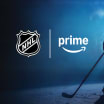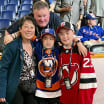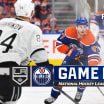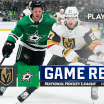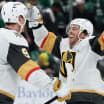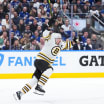Brian Leetch knew the names on the United States roster, and that those players could do something special at the 1996 World Cup of Hockey.
Still, Leetch needed to be told, needed to have the message hammered into him every single day, that the United States could win the tournament and that it was OK to have high expectations and not just hope.
A dozen years of representing the United States at international tournaments, including multiple IIHF World Junior Championships, the Olympics and the Canada Cup, had clouded Leetch's judgment on just what was to be expected from an American team.
1996 World Cup champs believed they could be great
United States team members to be inducted into U.S. Hockey Hall of Fame
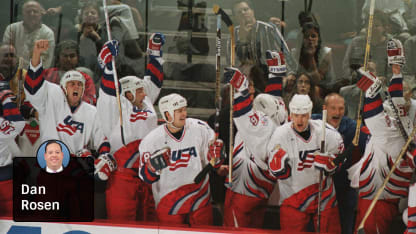
"I had been playing for U.S. teams since I was 16 years old, and that's how we went into the tournaments: We wanted to play our best, execute and do well, but we knew we weren't as good as the teams we were playing," Leetch said. "There was confidence, but there was also hope that you could keep it close, be in the game, so you could do something special to win those games. That had been repeated for me in most of the tournaments I was in."
Not in this one. Not this time.
U.S. general manager Lou Lamoriello and coach Ron Wilson made it clear to the players from Day One of training camp in Providence, Rhode Island, that the United States could be the team to beat at the World Cup, and that it would be if they bought in right then and there.
"It sunk in," Leetch said. "Instead of it just being, 'We're going to have a good team and we might have a chance to compete,' it was, 'You're darn right we have a great chance here and we should have high expectations.' It was great to have that constantly drilled in."
Wilson echoed the reminder every day, and it paid off on Sept. 14 when the United States won the tournament with a third-period comeback to defeat Canada 5-2 in Montreal in the third and deciding game of the final.
The win changed everything for USA Hockey. It got the people associated with the organization and the players coming up through the ranks to believe that they, too, should have high expectations, that second place wasn't good enough.
Twenty years later, with USA Hockey now a superpower in the international hockey world, the team that became the model for the next generation of U.S. stars will be inducted into the United States Hockey Hall of Fame. The 1996 World Cup team will be inducted with former NHL forward Craig Janney and longtime high school coach Bill Belisle at a ceremony in Philadelphia on Wednesday.
"I knew we could do it, I just had to make sure that our players believed that they were good enough to do it," Wilson said of winning the World Cup. "We were the best team in the world. We hadn't played a game or hadn't done anything yet, but I truly believed we were the best team in the world."
Wilson gets a particular amount of credit from the players for the job he did, which in the end looks so simple but during the process really wasn't.
"I think that's a problem. When you get a great talented bunch of guys together for the Olympics or the World Cup, it can be really easy looking for the coach, but you can disassemble it as quick as it could be successful," said forward Mike Modano, one of six Hockey Hall of Fame players from the 1996 team. "That's really the fine line with the guys who pick the national teams or Olympic teams. There seems to be more of a fear of ruining the situation rather than making it a great experience."
Wilson didn't succumb to that pressure.
His first task was to identify the starting goalie. He was choosing between Mike Richter, who won the Stanley Cup with the New York Rangers in 1994, and Jim Carey, who was coming off a Vezina Trophy-winning season with the Washington Capitals.
"Jim Carey had won the Vezina Trophy and he was very good," Wilson said. "But in training camp, right off the bat, I saw that he wasn't ready for this kind of assignment [and] that it was going to be Mike Richter."
Richter won five of his six starts with a 2.43 goals-against average and .920 save percentage. Guy Hebert got one start and won it. Carey never played.
"He was fantastic," Wilson said of Richter.
To figure out the line combinations, Wilson started with the two best forwards, Modano and Brett Hull. He knew Modano needed big, physical wings to allow him to be at his best. Keith Tkachuk and Bill Guerin were those guys. They stayed together for the duration of the tournament and combined for 14 points, including five goals by Tkachuk in seven games.
"It was simple," Tkachuk said. "Mike is the guy with the puck, skating, and Billy and I were going to bring some physical presence, get around the net, work the corners, give Mike room to do his thing."
Wilson knew Hull needed someone to get him the puck in the way that Adam Oates did when they played together with the St. Louis Blues from 1989-92. Doug Weight was the perfect fit. Hull led the United States with seven goals and 11 points. Weight had four assists and seven points.
Hull scored the tying goal with 3:18 remaining in Game 3 against Canada.
"I knew that Dougie could pass the puck, so I had to put those two guys together," Wilson said.
Scott Young joined Hull and Weight on the second line because of his defensive ability. Wilson used Bryan Smolinski and Pat LaFontaine to center the third and fourth lines.
He wanted a third line that could be more offensive, so he played John LeClair and Tony Amonte with Smolinski, who Wilson said was the most underrated player on the team.
Smolinski had five assists. LeClair had six goals and 10 points. Amonte had six points, including the game-winning goal with 2:35 left in Game 3 against Canada.
Joel Otto and Adam Deadmarsh were the regulars with LaFontaine on the fourth line. Steve Konowalchuk, Brian Rolston and Shawn McEachern each got into one game.
"No one said, 'Well, I'm better if I'm playing with so and so on the left,' or, 'I like to have a right-handed shot if I'm a left-handed centerman,'" Modano said. "Stupid little things like that you can normally hear guys complain about on their regular team, there was really nothing of that nature."
Wilson didn't have to put much thought into the defense pairs.
It was natural to put Chris Chelios with Gary Suter. They were partners with the Chicago Blackhawks, so it was assumed they would bring a similar style and game to the World Cup.
Wilson used Leetch with Derian Hatcher, a puck-mover with a stay-at-home tough defenseman. Wilson had the same philosophy with the third pair of Mathieu Schneider and Kevin Hatcher.
"I had Phil Housley as our extra defensemen, if you can believe that," Wilson said of the future Hall of Famer. "Once we established our team, I didn't have any complaints from anybody. I just didn't. It fell into place perfectly for our team."
Even with all that, the United States needed a signature moment to know for sure what Wilson and Lamoriello told them on the first day of training camp wasn't lip service.
It got it in its first game, a 5-3 win against Canada in Philadelphia on Aug. 31.
"It was in Philly and we weren't going to get pushed around," Tkachuk said. "We stood up to them and we beat them."
The United States rolled into the championship round with wins against Russia, Slovakia and Russia again by a combined 19-7.
"When we beat Canada in that first game, that set the tone for the whole tournament," Wilson said.
Their confidence didn't waver even after losing 4-3 in overtime to Canada in Game 1 of the best-of-3 final in Philadelphia.
"Ron was probably the most confident out of anybody," Tkachuk said. "When you have a coach like that, who is more confident than anybody else, it makes you feel good."
But the next two games were in Montreal.
"If people were taking bets on it, probably a couple thousand-to-one for us to go into Montreal and win two in a row," Modano said. "We had the personalities on our team that loved that kind of scenario, to go into that hostile environment and do something no one expected us to do."
They pulled it off with back-to-back 5-2 wins, the second a come-from-behind victory when they scored four goals in the final 3:18.
"Canada had always been the team that found a way in those big tournaments," Leetch said. "It was also Canada that figured out a way to win because someone would come up with the big goal. We had Tony Amonte do it, and Brett Hull."
Twenty years later, when you ask them how they did it, the first word they use is belief.
"We just had to go out there and play like winners, not like second place was good enough, because it just wasn't," Wilson said. "That's what I kept telling the team, that we're here and we're playing for one thing and one thing only, we're going to win this thing."
